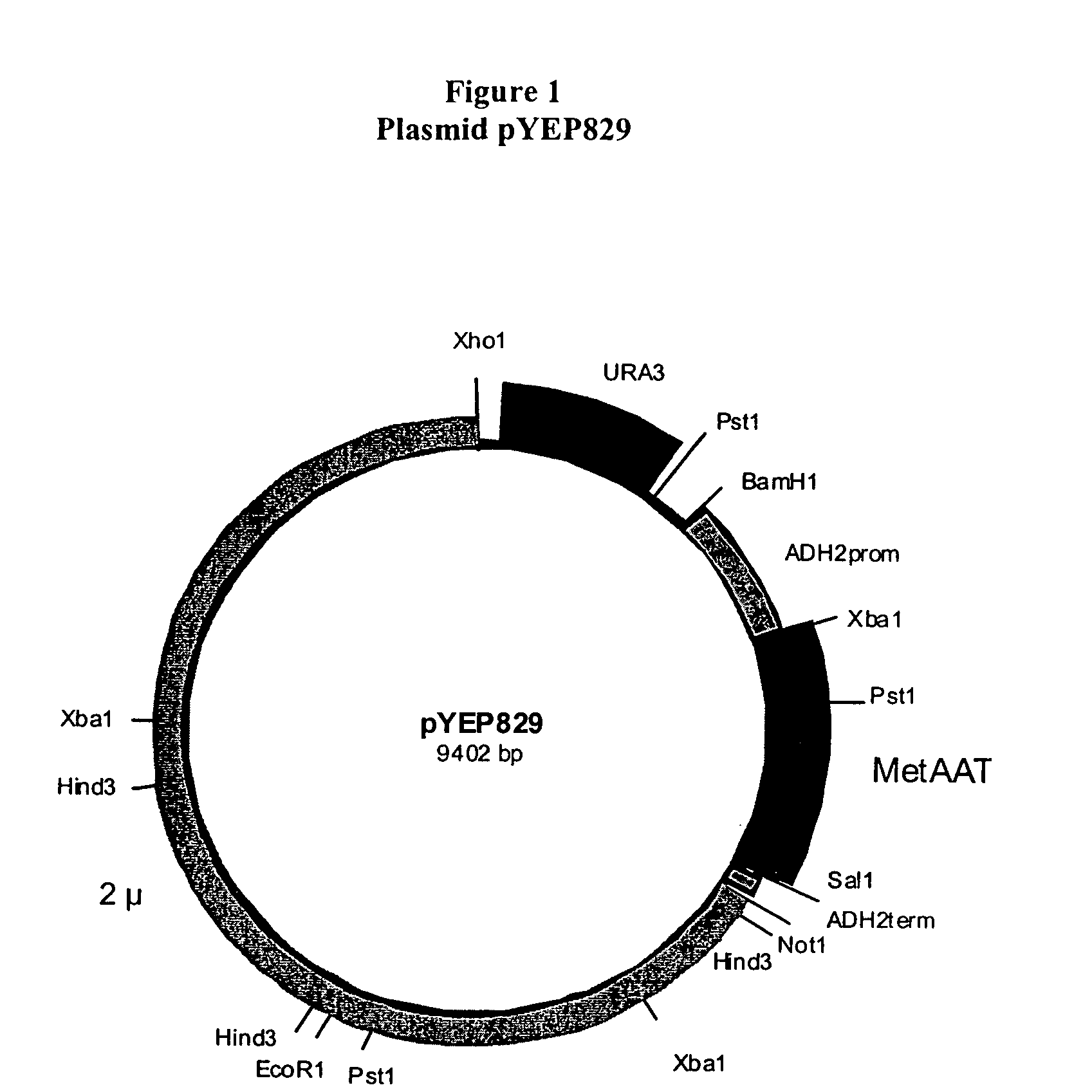Methods of protein production in yeast
a technology of protein production and yeast, which is applied in the direction of peptide sources, endopeptidases, peptides, etc., can solve the problem of difficult to produce aat in yeast in soluble form at high concentrations
- Summary
- Abstract
- Description
- Claims
- Application Information
AI Technical Summary
Benefits of technology
Problems solved by technology
Method used
Image
Examples
example 1
Construction of Plasmid pYEP829
[0089]This Example describes the construction of the plasmid pYEP829. The plasmid pYEP829 is an episomal expression plasmid that was constructed using ADH2 promoter and terminator sequences, the URA3 gene, and 2 micron sequences cloned de novo by PCR from yeast genomic DNA. It contains the human AAT gene, which was chemically synthesized by Sigma Genosys (The Woodlands, Tex.) using yeast-preferred codons. This yeast codon-based construct was used as a PCR template to generate the chemically synthesized human AAT gene (MetAAT).
[0090]The 2 micron sequence in this plasmid contains the origin for autonomous replication in yeast. The URA3 gene facilitates selection of transformed cells and retention of the plasmid during growth in uracil deficient medium. The expression of rAAT is controlled by the glucose-regulated ADH2 promoter. Growth of cells under glucose-limiting conditions induces continuous expression of rAAT and expression is inhibited when cells a...
example 2
Yeast Transformation and Selection of Clones
[0104]The pYEP829 ligation was transformed directly into the BJ2168[circle ]TRP yeast strains by the lithium acetate method. Selected transformants were plated on uracil minus plates (Ura-plates) and incubated until viable colonies were visible. Individual transformants were streaked onto Ura-plates and these patches were used to inoculate 3 mL of Ura- / 6% glucose cultures. The transformants were inoculated into YEPD, a non-selective medium for shake-flask expression analysis. Cultures were monitored for growth and analyzed for expression and solubility of rAAT at 72 hours. Six transformants of each strain were analyzed and clones selected for preparation of the glycerol stocks. Cells were grown to an optical density (OD) of ≧4.0, then sterile glycerol was added to a final concentration of 20%, and the cell bank vials were frozen at −80°±10° C. One such clone, designated #2E10-10, was used for subsequent fermentation studies.
[0105]Alternati...
example 3
Production of rAAT from pYEP829 / 2168 by the Fed Batch Process
[0111]The recombinant strain of S. cerevisiae used was ATCC#208277 (BJ2168), modified to trp revertant and circle 0 (2168[0]TRP), with plasmid pYEP829. Inoculum was prepared from glycerol stock (15-20% glycerol), stored at −70 to −80 ° C., no special temperature profile during freezing of the culture.
1) Starter Culture
1.1) Shake Flask:
[0112]In an appropriate sized flask (i.e. 250 mL), 1 / 10th of seed culture volume., 1:25 thawed, resuspended glycerol stock (1 mL into 25 mL medium) was inoculated. The flask was shaken at 200-250 RPM at 30° C. for 22-28 hrs, until the following criteria were found: OD600: 2.5-6; Glucose: 10-40 g / L; Ethanol: 5-25 g / L. Final samples were taken for a final OD600 reading, and glucose and ethanol concentrations.
2.2) Seed Culture:
[0113]Seed culture was prepared in 2.8 L Baffled Fernbach Flasks, to produce 1 / 10th of Production Fermentor Batch Volume. The flask was inoculated at 1:15 with above start...
PUM
| Property | Measurement | Unit |
|---|---|---|
| length | aaaaa | aaaaa |
| OD | aaaaa | aaaaa |
| temperature | aaaaa | aaaaa |
Abstract
Description
Claims
Application Information
 Login to View More
Login to View More - R&D
- Intellectual Property
- Life Sciences
- Materials
- Tech Scout
- Unparalleled Data Quality
- Higher Quality Content
- 60% Fewer Hallucinations
Browse by: Latest US Patents, China's latest patents, Technical Efficacy Thesaurus, Application Domain, Technology Topic, Popular Technical Reports.
© 2025 PatSnap. All rights reserved.Legal|Privacy policy|Modern Slavery Act Transparency Statement|Sitemap|About US| Contact US: help@patsnap.com



